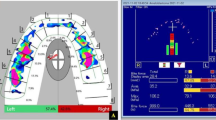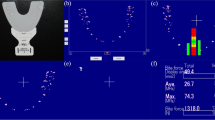Abstract
The purpose of this study was to clarify the relationship between two types of dental prescale systems. Forty healthy subjects were asked to maximally clench for about 3 s, and the maximum occlusal force before and after cleaning was calculated using an Occluzer FPD707 for dental prescale (P1) and a bite force analyzing system for dental prescale II (P2). The maximum occlusal forces measured by P1 and P2 were compared before cleaning and after cleaning. Next, the relationship between the maximum occlusal force by P1 and maximum occlusal force by P2 was investigated. In addition, comparisons were made between males and females. The maximum occlusal force after cleaning was significantly smaller than before cleaning for both P1 and P2. The reduction rate of the occlusal force was 4.1% for P1 and 25.9% for P2. Significant linearity was observed between the maximum occlusal forces of P1 and P2 (regression linear equation: y = 1.191x − 30.521, r = 0.980, p < 0.001). The maximum occlusal forces measured by P1 and P2 were both significantly larger in males than in females. It was suggested that there was a certain relationship between the maximum occlusal forces measured by dental prescale and dental prescale II, suggesting that it is possible to compare the results of both by applying corrections using a regression equation.


Similar content being viewed by others
References
Witter DJ, Woda A, Bronkhorst EM, Creugers NH. Clinical interpretation of a masticatory normative indicator analysis of masticatory function in subjects with different occlusal and prosthodontic status. J Dent. 2013;41:443–8.
Iwasaki M, Yoshihara A, Sato N, Sato M, Taylor GW, Ansai T, Ono T, Miyazaki H. Maximum bite force at age 70 years predicts all-cause mortality during the following 13 years in Japanese men. J Oral Rehabil. 2016;43:565–74.
Tasaka A, Kikuchi M, Nakanishi K, Ueda T, Yamashita S, Sakurai K. Psychological stress-relieving effects of chewing—relationship between masticatory function-related factors and stress-relieving effects. J Prosthodont Res. 2018;62:50–5.
Miyaura K, Matsuka Y, Morita M, Yamashita A, Watanabe T. Comparison of biting forces in different age and sex groups: a study of biting efficiency with mobile and non-mobile teeth. J Oral Rehabil. 1999;26:223–7.
Miyaura K, Morita M, Matsuka Y, Yamashita A, Watanabe T. Rehabilitation of biting abilities in patients with different types of dental prostheses. J Oral Rehabil. 2000;27:1073–6.
Miura H, Watanabe S, Isogai E, Miura K. Comparison of maximum bite force and denture status between healthy and frail elderly persons. J Oral Rehabil. 2001;28:592–5.
Okiyama S, Ikebe K, Nokubi T. Association between masticatory performance and maximal occlusal force in young men. J Oral Rehabil. 2003;30:278–82.
Karibe H, Ogata K, Hasegawa Y, Ogihara K. Relation between clenching strength and occlusal force distribution in primary dentition. J Oral Rehabil. 2003;30:307–11.
Sakaguchi K, Mehta NR, Abdallah EF, Forgione AG, Hirayama H, Kawasaki T, Yokoyama A. Examination of the relationship between mandibular position and body posture. Cranio. 2007;25:237–49.
Aras K, Hasanreisoğlu U, Shinogaya T. Masticatory performance, maximum occlusal force, and occlusal contact area in patients with bilaterally missing molars and distal extension removable partial dentures. Int J Prosthodont. 2009;22:204–9.
Motegi E, Nomura M, Tachiki C, Miyazaki H, Takeuchi F, Takaku S, Abe Y, Miyatani M, Ogai T, Fuma A, Fukagawa H, Kano M, Sueishi K. Occlusal force in people in their sixties attending college for elderly. Bull Tokyo Dent Coll. 2009;50:135–40.
Masumoto N, Yamaguchi K, Fujimoto S. Daily chewing gum exercise for stabilizing the vertical occlusion. J Oral Rehabil. 2009;36:857–63.
Goshima K, Lexner MO, Thomsen CE, Miura H, Gotfredsen K, Bakke M. Functional aspects of treatment with implant-supported single crowns: a quality control study in subjects with tooth agenesis. Clin Oral Implants Res. 2010;21:108–14.
Ikebe K, Matsuda K, Kagawa R, Enoki K, Yoshida M, Maeda Y, Nokubi T. Association of masticatory performance with age, gender, number of teeth, occlusal force and salivary flow in Japanese older adults: is ageing a risk factor for masticatory dysfunction? Arch Oral Biol. 2011;56:991–6.
Fueki K, Yoshida E, Igarashi Y. A structural equation model to investigate the impact of missing occlusal units on objective masticatory function in patients with shortened dental arches. J Oral Rehabil. 2011;38:810–7.
Shiga H, Kobayashi Y, Katsuyama H, Yokoyama M, Arakawa I. Gender difference in masticatory performance in dentate adults. J Prosthodont Res. 2012;56:166–9.
Makino E, Nomura M, Motegi E, Iijima Y, Ishii T, Koizumi Y, Hayashi M, Sueishi K, Kawano M, Yanagisawa S. Effect of orthodontic treatment on occlusal condition and masticatory function. Bull Tokyo Dent Coll. 2014;55:185–97.
Kuninori T, Tomonari H, Uehara S, Kitashima F, Yagi T, Miyawaki S. Influence of maximum bite force on jaw movement during gummy jelly mastication. J Oral Rehabil. 2014;41:338–45.
Morokuma M, Yoneyama Y, Matsuda R, Hosoi T, Ohkubo C. Influence of occlusal force on electroencephalograms in edentulous patients. J Prosthodont. 2015;24:532–7.
Chong MX, Khoo CD, Goh KH, Rahman F, Shoji Y. Effect of age on bite force. J Oral Sci. 2016;58:361–3.
Kosaka T, Ono T, Kida M, Kikui M, Yamamoto M, Yasui S, Nokubi T, Maeda Y, Kokubo Y, Watanabe M, Miyamoto Y. A multifactorial model of masticatory performance: the Suita study. J Oral Rehabil. 2016;43:340–7.
Nogawa T, Takayama Y, Ishida K, Yokoyama A. Comparison of treatment outcomes in partially edentulous patients with implant-supported fixed prostheses and removable partial dentures. Int J Oral Maxillofac Implants. 2016;31:1376–83.
Qi K, Guo SX, Xu Y, Deng Q, Liu L, Li B, Wang MQ. An investigation of the simultaneously recorded occlusal contact and surface electromyographic activity of jaw-closing muscles for patients with temporomandibular disorders and a scissors-bite relationship. J Electromyogr Kinesiol. 2016;28:114–22.
Yoon W, Hwang S, Chung C, Kim KH. Changes in occlusal function after extraction of premolars: 2-year follow-up. Angle Orthod. 2017;87:703–8.
Kon K, Shiota M, Sakuyama A, Ozeki M, Kozuma W, Kawakami S, Kasugai S. Evaluation of the alteration of occlusal distribution in unilateral free-end and intermediate missing cases. J Oral Implantol. 2017;43:3–7.
Tanaka M, Bruno C, Jacobs R, Torisu T, Murata H. Short-term follow-up of masticatory adaptation after rehabilitation with an immediately loaded implant-supported prosthesis: a pilot assessment. Int J Implant Dent. 2017;3:8. https://doi.org/10.1186/s40729-017-0070-x.
Watanabe C, Wada J, Mizutani K, Watanabe H, Wakabayashi N. Chronological grey scale changes in supporting alveolar bone by removable partial denture placement on patients with periodontal disease: a 6-month follow-up study using digital subtraction analysis. J Dent. 2017;63:8–13.
Ikebe K, Gondo Y, Kamide K, Masui Y, Ishizaki T, Arai Y, Inagaki H, Nakagawa T, Kabayama M, Ryuno H, Okubo H, Takeshita H, Inomata C, Kurushima Y, Mihara Y, Hatta K, Fukutake M, Enoki K, Ogawa T, Matsuda K, Sugimoto K, Oguro R, Takami Y, Itoh N, Takeya Y, Yamamoto K, Rakugi H, Murakami S, Kitamura M, Maeda Y. Occlusal force is correlated with cognitive function directly as well as indirectly via food intake in community-dwelling older Japanese: from the SONIC study. PLoS ONE. 2018;13:e0190741. https://doi.org/10.1371/journal.pone.0190741.
Sagawa K, Furuya H, Ohara Y, Yoshida M, Hirano H, Iijima K, Kikutani T. Tongue function is important for masticatory performance in the healthy elderly: a cross-sectional survey of community-dwelling elderly. J Prosthodont Res. 2019;63:31–4.
Hatch JP, Shinkai RS, Sakai S, Rugh JD, Paunovich ED. Determination of masticatory performance in dentate adults. Arch Oral Biol. 2001;46:641–8.
Funding
The authors received no support from any grant.
Author information
Authors and Affiliations
Corresponding author
Ethics declarations
Conflict of interest
The authors declare that they have no conflict of interest.
Additional information
Publisher's Note
Springer Nature remains neutral with regard to jurisdictional claims in published maps and institutional affiliations.
Rights and permissions
About this article
Cite this article
Shiga, H., Komino, M., Uesugi, H. et al. Comparison of two dental prescale systems used for the measurement of occlusal force. Odontology 108, 676–680 (2020). https://doi.org/10.1007/s10266-020-00509-9
Received:
Accepted:
Published:
Issue Date:
DOI: https://doi.org/10.1007/s10266-020-00509-9




